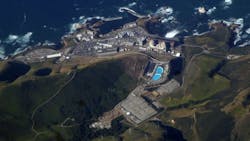PG&E to Phase Out Nuclear Power
PG&E has announced a joint proposal with labor and environmental organizations that would increase investment in energy efficiency, renewables and storage beyond current state mandates while phasing out PG&E's production of nuclear power in California by 2025.
Underpinning the agreement is the recognition that California's new energy policies will significantly reduce the need for Diablo Canyon's electricity output. There are several contributing factors, including the increase of the Renewable Portfolio Standard to 50 percent by 2030, doubling of energy efficiency goals under SB 350, the challenge of managing overgeneration and intermittency conditions under a resource portfolio increasingly influenced by solar and wind production, the growth rate of distributed energy resources, and the potential increases in the departure of PG&E's retail load customers to Community Choice Aggregation.
The Joint Proposal would replace power produced by two nuclear reactors at the Diablo Canyon Power Plant (DCPP) with a cost-effective, greenhouse gas free portfolio of energy efficiency, renewables and energy storage. It includes a PG&E commitment to a 55 percent renewable energy target in 2031, an unprecedented voluntary commitment by a major U.S. energy company.
The parties to the Joint Proposal are PG&E, International Brotherhood of Electrical Workers Local 1245, Coalition of California Utility Employees, Friends of the Earth, Natural Resources Defense Council, Environment California and Alliance for Nuclear Responsibility.
"California's energy landscape is changing dramatically with energy efficiency, renewables and storage being central to the state's energy policy. As we make this transition, Diablo Canyon's full output will no longer be required. As a result, we will not seek to relicense the facility beyond 2025 pending approval of the joint energy proposal. Importantly, this proposal recognizes the value of GHG-free nuclear power as an important bridge strategy to help ensure that power remains affordable and reliable and that we do not increase the use of fossil fuels while supporting California's vision for the future," said PG&E Corporation Chairman, CEO and President Tony Earley.
He added, "Supporting this is a coalition of labor and environmental partners with some diverse points of view. We came to this agreement with some different perspectives—and we continue to have some different perspectives—but the important thing is that we ultimately got to a shared point of view about the most appropriate and responsible path forward with respect to Diablo Canyon and how best to support the state's energy vision."
"We are incredibly proud of the men and women who have made Diablo Canyon one of the finest nuclear stations in the country and who, in doing so, have provided our state with GHG-free energy for three decades. We are committed to supporting our valued employees and the community and we will advocate on their behalf throughout this process. We believe the transition period included in this proposal represents a responsible approach that allows time for the needs of employees and the community to be properly addressed," said PG&E President, Electric, Geisha Williams.
Key Elements of the Joint Proposal
Under the terms of this Joint Proposal, PG&E will retire Diablo Canyon at the expiration of its current Nuclear Regulatory Commission (NRC) operating licenses. The parties will jointly propose and support the orderly replacement of Diablo Canyon with GHG-free resources.
Recognizing that the procurement, construction and implementation of a greenhouse gas free portfolio of energy efficiency, renewables and storage will take years, the parties recognize that PG&E intends to operate Diablo Canyon to the end of its current NRC operating licenses, which expire on November 2, 2024 (Unit 1), and August 26, 2025 (Unit 2).
This eight- to nine-year transition period will provide the time to begin the process to plan and replace Diablo Canyon's energy with new GHG-free replacement resources.
PG&E will immediately cease any efforts on its part to renew the Diablo Canyon operating licenses and will ask the NRC to suspend consideration of the pending Diablo Canyon license renewal application pending withdrawal with prejudice of the NRC application upon California Public Utilities Commission (CPUC) approval of the Joint Proposal Application.
PG&E does not believe customer rates will increase as a result of the Joint Proposal because it believes it is likely that implementing the proposal will have a lower overall cost than relicensing DCPP and operating it through 2044. Factors affecting this include, in addition to lower demand, declining costs for renewable power and the potential for higher renewable integration costs if DCPP is relicensed.
Commitment to Employees and the Community
The parties to the agreement are jointly committed to supporting a successful transition for DCPP employees and the community.
PG&E's DCPP Retention Program will provide, among other things, incentives to retain employees during the remaining operating years of the plant, a retraining and development program to facilitate redeployment of a portion of plant personnel to the decommissioning project or other positions within the company, and severance payments upon the completion of employment. PG&E has reached agreement on these benefits with IBEW Local 1245 and will immediately engage in bargaining with its other labor unions to ensure appropriate benefits for represented employees.
In addition, the Joint Proposal includes payments by PG&E to San Luis Obispo County totaling nearly $50 million. The proposed payments are designed to offset declining property taxes through 2025 in support of a transition plan for the county.
Agreement Contingencies
The Joint Proposal is contingent on a number of important regulatory actions, including:
- Approval of a lease extension from the State Lands Commission without which the company cannot operate DCPP beyond 2018.
- Approval by the CPUC of the proposed plan for replacement of Diablo Canyon with greenhouse gas free resources. Any resource procurement PG&E makes will be subject to a non-bypassable cost allocation mechanism that ensures all users of PG&E's grid pay a fair share of the costs.
- CPUC confirmation that PG&E's investment in DCPP will be recovered by the time the plant closes in 2025.
- CPUC approval of cost recovery for appropriate employee and community transition benefits.
